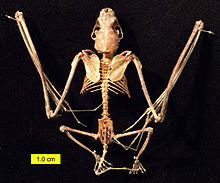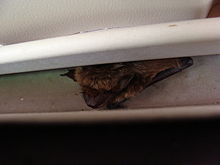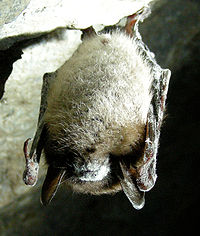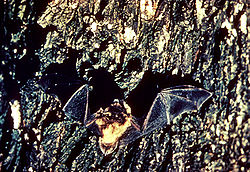- Little brown bat
-
Little brown bat 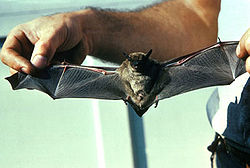
Conservation status Scientific classification Kingdom: Animalia Phylum: Chordata Class: Mammalia Order: Chiroptera Family: Vespertilionidae Subfamily: Myotinae Genus: Myotis Species: M. lucifugus Binomial name Myotis lucifugus
(LeConte, 1831)
The little brown bat (sometimes called little brown myotis) (Myotis lucifugus) is a species of the genus Myotis (mouse-eared bats), one of the most common bats of North America. The little brown bat has been a model organism for studying bats.
Contents
Description
As suggested by the bat’s name, its fur is uniformly dark brown and glossy on the back and upper parts with slightly paler, greyish fur underneath.[2] Wing membranes are dark brown on a typical wingspan of 22–27 cm (8.7–11 in). Ears are small and black with a short, rounded tragus. Adult bats are typically 6–10 cm (2.4–3.9 in) long and weigh 5–14 grams (0.2–0.5 oz). Females tend to be larger than males. The fore and hind limbs have five metapodials. The skull of the brown bat lacks a sagittal crest. Its rostrum is shortened and has upslope profile of the forehead. Its braincase flattened and sub-circular when observed dorsally. The bat has 38 teeth all of which including molars are relatively sharp, as is typical for an insectivore, and canines are prominent to enable grasping hard-bodied insects in flight.
The little brown bat can be distinguished from the Indiana bat by the lack of a keel on the caclar and the presence of hairs on the hind feet that extend pass the toes. Compared to the long-legged bat, the brown bat has a shorter tibia and lesser amounts of hair on the undersurface of the wing in addition to the lack of a keel on the caclar.[3]
Range and ecology
The little brown bat is found throughout much North America.[4] It is most common in the northern half of the continental United States and southern Canada. Most specimens from the northern edge of its range are males although nursery roosts have been found in the Yukon. Brown bats have been found in Iceland and Kamchatka, likely due to accidental ship transportation by humans.[4]
Habitat and roosting
The little brown bat lives in three different roosting sites: day roosts, night roost and hibernation roosts.[4] Day and night roosts are used by active in spring, summer and fall while hibernacula are used in winter. Day roost sites are typically found in buildings, trees, under rock in wood piles and sometimes in caves. Nursery roosts are found in hollow trees and other natural crevices as well as around buildings. Nursery roosts have also been found under sheet metal roofs of trapper’s caches[5] and attics of buildings.[6] Night roosts tend to be in the same buildings as day roosts, however these roosts tend to be confined spaces with many bats packing themselves together to increase roost temperature. Bats congregate in night roosts after feeding in the evening. Thus night roosting could result in the accumulation of feces away from the day roosts which could make the latter less conspicuous to predators.[4] Brown bats usually hibernate in caves and sometimes abandoned mines. Northern populations of bats enter hibernation in early September and end in mid-May while southern populations enter in November and ends in mid-March.[4]
Diet
Little brown bats are insectivores, eating moths, wasps, beetles, gnats, mosquitoes, midges and mayflies, among others.[7] Since many of their preferred meals are insects with an aquatic life stage, such as mosquitoes, they prefer to roost near water. Brown bats feed along the margins of lakes and streams, zig-zagging in and out of vegetation 2–5 cm above the ground.[8] Later in the evening, they usually forage in groups over water staying within 1-2m above the surface. They echolocate to find their prey. They are very effective predators when the insect are in patches and at close range. As with other insectivorous bats, little brown bats catch prey by aerial hawking and gleaning tactics.[9] When taken in flight, the prey is taken by swooping or dipping maneuvers. When above water, prey is taken by the mouth.
Brown bat do not claim feeding areas like a territory, however individuals frequently return to the same feeding sites.[4] When hunting swarms, brown bats focus on one or two species to feed on. When insect are more scattered, they are less selective and will feed on multiple species. If they do not catch any food, they will enter a torpor similar to hibernation that day, awakening at night to hunt again. A bat will eat half of their body weight per night with lactating females eating more than their body weight per night.
The bats' diet makes this species beneficial to agriculture as it eats many species of agricultural pests. Other than that, it can pollinate crops.
Mortality
Brown bats live approximately 6 to 7 years and often live well beyond 10 years. Little brown bats are preyed on by a variety of animals including, small carnivores, birds, rats and snakes. Many predators take advantage of the high concentrations of bats in roosts.[4] Predators such as martens and fishers take advantage of weak young that fall or hibernating individuals that are dislodged by grooming activities. Brown bats are also hosts for various parasites such as fleas, bed bugs and lice.[4] Little brown bats are now at a higher threat due to white nose syndrome in eastern North America.[10] Many states have made special considerations with respect to the disease, including listing them as a sensitive or protected species. Accidents are more common causes of mortality than predator or parasites.[11] Bats are impaled on barbed wire and burdocks and drown by floodings in hibernacula. Pesticides also cause great mortality. However DDT has little effect on the bats[12] and they also seem to have low levels of rabies.[13]
Sleep
Further information: Sleep (non-human)The average sleep time of a little brown bat in captivity is said to be 19.9 hours per day. This long period of sleep is thought to be a way of conserving energy, by only hunting for a few hours each night when their insect prey are available.[14]
Behavior
As with most bats, the little brown bat is nocturnal, emerging its roosts at dusk. Most activity occurs two or three hours after dusk. They are also active before dawn. Brown bats return to their roost around 4-5 o’clock in the morning. Since little brown bats live in a temperate zone, they must find some way of dealing with winter. Most temperate bats either migrate or hibernate, but little brown bats do both. In summer, the males and females live apart, the females raise the young. When fall comes, both sexes fly south to a hibernaculum, where they mate and then hibernate. Little brown bats undergo a prolonged period of hibernation during the winter due to the lack of food. They hibernate in caves as a community
Echolocation and communication
Little brown bats produce calls that are high intensity frequency modulated (FM) and that last from less than one millisecond (ms) to about 5 ms and sweep from about 80–40 kHz, with most of their energy at 45 kHz.[8] When cruising, bats usually produce 20 calls per second to detect prey and objects.[4][8] The rate of call production while chasing prey is 200 calls per second. The bat emits a high-pulse repetitive call when nearing a landing site.[8]
When on a collision course, feeding bats will alert each other by vocalizing or "honking". These honks are made by reducing the frequency of the terminal portion of a sweep call to 25 kHz.[8] They are the only non-echolocation sound done by this species when feeding.[4] The bats also seem to use echolocation calls of conspecifics to locate roosting sites. These calls are usually used by males calling from mating sites within hibernacula.[15] Mother and young communicate through a few, complex vocalizations.
Mating and reproduction
At least in Ontario, brown bat mating occurs in two phases, active and passive. In the active phase, both partners are awake and alert. In the passive state, male will mate with torpid individuals of both sexes,[15] with 35% of mating being homosexual. Most mating occurs in the active phase, corresponding to the peak in testosterone levels in plasma. There is some conflicting reports on whether active females store sperm.[4] Active mating peaks in August but passive mating continues into the winter.[4] During mating, the male mounts the female from the rear and may use copulation call to calm her and stop struggling.[16] The mating system is described as indiscriminate and promiscuous.[15] Neither males nor females can protect any investment in choosing their mates. Torpid males cannot have a monopoly on females and torpid females are often inseminated by other males when they are in the passive phase.[4] Males will mate with as many females as possible and females mate more than once.[15]
When they arise in the spring, the females go to nursery colonies which may often be the same place where they were born. These nursery colonies consist mainly of adult females and their young and can be located in the attics of warm buildings where there is high humidity. These colonies sometimes reach numbers of bats as great as 1,000 per cave/forest. Gestation lasts 50–60 days.[4] They usually have one baby per female each year, sometimes twins, born sometime from late May to early July. The young are born in an altricial state with their eyes closed and will hang in the nursery while their mothers forage at night. Their eyes open on their second day. They cling to a nipple constantly until they are two weeks old. At three weeks, they learn to fly. By fours weeks, they are adult sized.[4] Females may be sexually mature in the fall after their birth, but males may take a year longer. About half of females and most males breed during their first autumn.
Genome projects
The genome of M. lucifugus has already been sequenced at low (2x) coverage for the Mammalian Genome Project. It has also been selected for more complete (approximately 7x coverage) genome sequencing. This species is also part of the ENCODE comparative sequencing project.
References
- ^ Arroyo-Cabrales, J. & Ticul Alvarez Castaneda, S. (2008). "Myotis lucifugus". IUCN Red List of Threatened Species. Version 2009.2. International Union for Conservation of Nature. http://www.iucnredlist.org/apps/redlist/details/14176. Retrieved 08 February 2010.
- ^ Ohio DNR: Little Brown Bat
- ^ Barbour, R., W. Davis. (1969) Bats of America, Lexington, Kentucky: The University Press of Kentucky.
- ^ a b c d e f g h i j k l m n o Fenton, M., R. Barclay. (1980) "Myotis lucifugus", Mammalian Species, 142: 1-8.
- ^ Youngman, P. M. (1975) "Mammals of the Yukon Territory". Nat. Mus. Canada, Publs. Zool., 10:1-192.
- ^ Davis, W.H., and H.B. Hitchcock. (1965) "Biology and migration of the bat, Myotis lucifigus, in New England", Journal of Mammalogy, 46:296-313.
- ^ Belwood, J., M. Fenton. (1976) "Variation in the diet of Myotis lucifugus (Chiroptera:Vespertilionidae)", Canadian Journal of Zoology, 54: 1674-1678.
- ^ a b c d e Fenton, M., G. Bell. (1979) "Echolocation and feeding behaviour in four species of Myotis (Chiroptera)", Canadian Journal of Zoology, 57: 1271-1277.
- ^ Ratcliffe, J., J. Dawson. (2003) "Behavioural flexibility: the little brown bat, Myotis lucifugus, and the northern long-eared but, M. septentrionalis, both glean and hawk prey". Animal Behaviour, 66: 847-856.
- ^ BBC News, "disease 'killed one million bats'", 5 August 2010.
- ^ Richard H. MANVILLE, (1963) "ACCIDENTAL MORTALITY IN BATS", Mammalia, 27(3):361–366
- ^ KUNZ, T. H., E. L. P. ANTHONY, AND W. T. RUMAGE. III, (1977) "Mortality of little brown bats following multiple pesticide applications", J. Wildl. Manage, 41:476-483
- ^ Trimarchi, C. V., (1978) "Rabies in insectivorous temperate-zone bats", Bat Research News 9(1):7-12
- ^ "40 Winks?" Jennifer S. Holland, National Geographic Vol. 220, No. 1. July 2011.
- ^ a b c d Donald W. Thomas, M. Brock Fenton and Robert M. R. Barclay, (1979) "Social Behavior of the Little Brown Bat, Myotis lucifugus: I. Mating Behavior", "Behavioral Ecology and Sociobiology", 6(2): 129-136.
- ^ Robert M. R. Barclay and Donald W. Thomas, (1979) "Copulation Call of Myotis lucifugus: A Discrete Situation-Specific Communication Signal", Journal of Mammalogy, 60(3): 632-634.
- Eisenberg, John F. The Mammalian Radiations: An Analysis of Trends in Evolution, Adaptation, and Behavior. The University of Chicago Press: Chicago, 1981.
External links
- IUCN Red List of Threatened Species: Myotis lucifungus
- Ohio Department of Natural Resources Life History Notes: Little Brown Bat
- Wild About Gardening.org's page on Little Brown Bats
- BBC - Science & Nature - Wildfacts - Little brown bat
- Little Brown Bat - Colorado Division of Wildlife
- Bat Man vs. White Nose, article with video, Sept 10, 2009
Categories:- IUCN Red List least concern species
- Mouse-eared bats
- Mammals of North America
- Mammals of the United States
- Sequenced genomes
- Model organisms
Wikimedia Foundation. 2010.


